
Tulbaghia is a genus of monocotyledonous herbaceous perennial bulbs native to Africa, belonging to the amaryllis family. It is one of only two known genera in the society garlic tribe within the onion subfamily. The genus was named for Ryk Tulbagh (1699–1771), one time governor of The Cape of Good Hope.
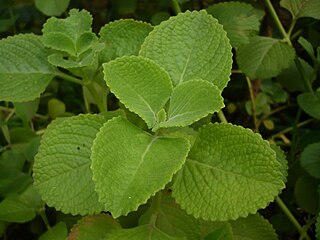
Coleus amboinicus, synonym Plectranthus amboinicus, is a semi-succulent perennial plant in the family Lamiaceae with a pungent oregano-like flavor and odor. Coleus amboinicus is considered to be native to parts of Africa, the Arabian Peninsula, and India, although it is widely cultivated and naturalized elsewhere in the tropics where it is used as a spice and ornamental plant. Common names in English include Indian borage, country borage, French thyme, Indian mint, Mexican mint, Cuban oregano, broad leaf thyme, soup mint, Spanish thyme. The species epithet, amboinicus refers to Ambon Island, in Indonesia, where it was apparently encountered and described by João de Loureiro (1717–1791).

Kniphofia is a genus of perennial flowering plants in the family Asphodelaceae, first described as a genus in 1794. All species of Kniphofia are native to Africa. Common names include tritoma, red hot poker, torch lily and poker plant.

Euclea, from the Greek eukleia meaning "glory and fame", denotes a group of flowering plants in the Ebenaceae or ebony family. They were described as a genus by Linnaeus in 1774. The genus includes evergreen trees and shrubs, native to Africa, the Comoro Islands and Arabia. Several species are used for timber, producing a hard, dark heartwood timber similar to ebony.

Plectranthus is a genus of about 85 species of flowering plants from the sage family, Lamiaceae, found mostly in southern and tropical Africa and Madagascar. Common names include spur-flower. Plectranthus species are herbaceous perennial plants, rarely annuals or soft-wooded shrubs, sometimes succulent; sometimes with a tuberous base.

Zamioculcas is a genus of flowering plants in the family Araceae, containing the single species Zamioculcas zamiifolia. It is a tropical herbaceous perennial plant, and is native to eastern Africa, including Kenya, KwaZulu-Natal, Malawi, Mozambique, Tanzania, and Zimbabwe. Its common names include Zanzibar gem, ZZ plant, Zuzu plant, aroid palm, eternity plant and emerald palm. It is grown as a houseplant, mainly because it has attractive glossy foliage and is easy to care for. Zamioculcas zamiifolia is winter-hardy in USDA Zones 9 and 10.

Plectranthus verticillatus, Swedish ivy, Swedish begonia or whorled plectranthus is a plant in the family Lamiaceae (Labiatae), genus Plectranthus. Despite its common name, it is not close to the ivy family of the genus Hedera.

Aloidendron barberae, formerly Aloe bainesii and Aloe barberae, also known as the tree aloe, is a species of succulent plant in the genus Aloidendron. It is native to South Africa northwards to Mozambique. In its native climes this slow-growing tree can reach up to 60 feet (18 m) high and 36 inches (0.91 m) in stem diameter. An A. barberae planted at the Kirstenbosch Botanical Garden in Cape Town in 1922 had by 2011 grown to have a basal diameter of ten feet. Aloidendron barberae is Africa's largest aloe-like plant. The tree aloe is often used as an ornamental plant. Its tubular flowers are rose pink (green-tipped); it flowers in winter and in its natural environment is pollinated by sunbirds.
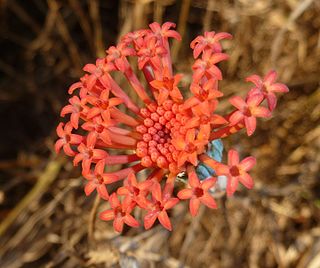
Kleinia fulgens, commony known as the coral senecio, is a species of flowering plant in the genus Kleinia and the family Asteraceae native to Southern Africa, which used to be of the genus Senecio.
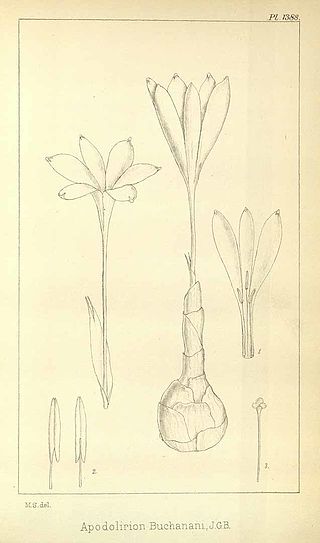
Apodolirion is a genus of herbaceous, perennial and bulbous plants in the Amaryllis family. It consists of 6 species distributed in South Africa. The name Apodolirion comes from the Greek and means "stemless flower" and describes the almost sessile flowers of these species.
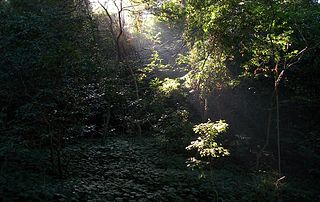
Areas of forest which grow in KwaZulu-Natal, South Africa mostly on south facing slopes in higher rainfall areas, and along the humid coastal areas. Different types of forest can be identified by their species composition which depends mostly on the altitude, latitude and substrate in which they grow. South facing slopes are favourable for the development of forest as they are more shaded, and therefore cooler and retain more moisture than the northern slopes. The extra moisture on the south slopes is not only favoured by forest trees, but also helps to prevent or subdue wildfires. Fires can also be blocked by cliff faces and rocks or boulders on these slopes, and by streams or rivers at the base of the slopes. The coastal regions are conducive to forest formation, because of high rainfall and humidity which are favoured by forest trees and also help to prevent or subdue fires. The rivers of the coastal areas are also broader than further inland, which may often prevent fires from spreading long distances, and fires generally burn uphill and therefore more often away from areas at low altitude.
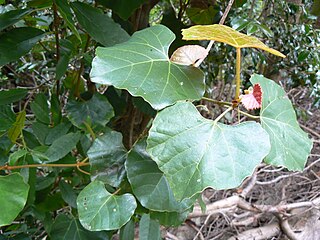
Rhoicissus tomentosa is a vigorous, evergreen vine that is indigenous to the afro-montane forests of southern Africa. It is increasingly popular as an ornamental creeper in gardens, and it has a wide range of uses in traditional medicine.

Mikania natalensis, the Natal mikania, is a plant in the family Asteraceae, and is native to Africa.

Dalbergia armata is a scrambling, deciduous species of legume that is native to subtropical to temperate regions of southeastern Africa. The robust, woody liana or small tree is armed with strong spines on the main stem and branches. It occurs sparsely or commonly in forest, bush, riparian fringes and in wooded ravines. It is sometimes employed as a bonsai subject, and it can be propagated from either seed or cuttings.
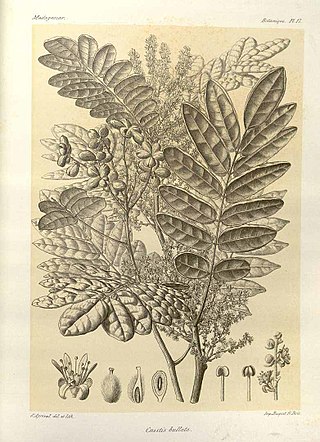
Cnestis polyphylla, or itch pod, is a liane or scrambling shrub belonging to the family Connaraceae and occurring south from Kenya in East Tropical Africa through Mozambique and Zimbabwe to Southern Africa where it is found in coastal and escarpment forest in Limpopo, Mpumalanga, Eswatini and KwaZulu-Natal, and further south to the Eastern Cape. It also grows on the Indian Ocean islands of Madagascar, Mauritius and Réunion. The genus has at least 13 species with many still unresolved. They are distributed mainly in tropical Africa and nearby islands, but extend to SE Asia and China.

Crassula nudicaulis is a succulent plant native to South Africa, and Lesotho.
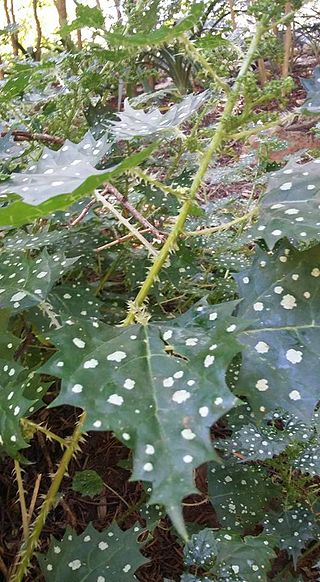
Laportea grossa, or spotted nettle, is an African plant in the family Urticaceae, and one of 31 species in the genus. This species occurs in shady places in coastal and escarpment forests, closed woodland and on streambanks from George through the Eastern Cape, KwaZulu-Natal to southern Mozambique. Young leaves of this species are cooked and eaten as a vegetable.

Coleus neochilus, synonym Plectranthus neochilus, which is colloquially known as lobster bush, fly bush or mosquito bush, is a perennial ground cover with highly fragrant, partially scalloped, ovate leaves and purple blue inflorescent spikes.

Plectranthus ecklonii, commonly known as tall spurflower and Ecklon spurflower, is a shrub from the mint family Lamiaceae, native to South Africa. The habitat includes forest or shaded situations near the coast.
Plectranthus purpuratus or cliff spurflower is a species of flowering plant in the family Lamiaceae. It is native to South Africa's Kwazulu-Natal and Mpumalanga provinces, as well as eSwatini. The name is frequently misapplied to Plectranthus ciliatus, presumably because both have purple-backed leaves.



















